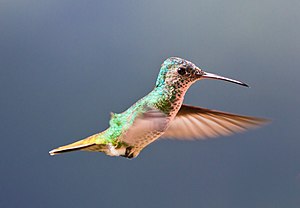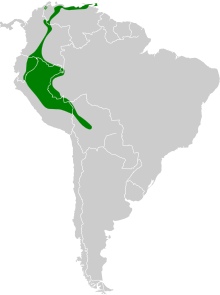Bronze tail sapphire hummingbird
| Bronze tail sapphire hummingbird | ||||||||||
|---|---|---|---|---|---|---|---|---|---|---|

Bronze tail sapphire hummingbird ♀ |
||||||||||
| Systematics | ||||||||||
|
||||||||||
| Scientific name of the genus | ||||||||||
| Chrysuronia | ||||||||||
| Bonaparte , 1850 | ||||||||||
| Scientific name of the species | ||||||||||
| Chrysuronia oenone | ||||||||||
| ( Lesson , 1832) |
The golden-tailed sapphire ( Chrysuronia oenone ) or bronze tail Sapphire is a species of bird in the family of hummingbirds (Trochilidae). The species has a large distribution area that extends over the countries of Colombia , Venezuela , Ecuador , Brazil , Peru and Bolivia . The IUCN assesses the population as Least Concern .
features
The bronze-tailed sapphire hummingbird reaches a body length of approx. 9.4 cm with a body weight of only approx. 5.3 g, whereby the slightly curved beak is 2 cm long. The upper bill is black, the lower bill reddish. The head and throat of the male glisten blue, but in the wild it looks like black. The back shimmers green. The upper tail-coverts are copper-red, while the slightly forked tail has a copper-gold color. Spread the tail so that it appears rounded. The breast and belly are green and the under tail-coverts are gray-brown. There is a distinct gender dimorphism . The head and top of the female shimmer green. As with males, the upper tail-coverts are copper-red, while the slightly forked tail has a copper-gold color. If you spread the tail, it also looks rounded. The outer control feathers are dense gray spots. The underside is white with green flecks on the sides, throat and chest. The under tail-coverts are gray-brown. Male juveniles resemble the females at first, but have bruises on the throat.
behavior
In the dry season they gather in large numbers in mighty tree tops with flowers. Both sexes spend a lot of time quarreling with other hummingbirds and chasing them away to defend their small feeding grounds. Occasionally you can also see them as solitary animals on plants such as the genus Palicourea, which belongs to the red family . Here they are present from the lower strata near the road to the upper treetops in smaller clearings of forest areas. Males are more territorial than females, but females are more likely to be seen traplining, i. That is, they regularly fly to specific flowers in rapid succession. Both sexes also hunt and collect tiny insects. In the rainy season the males sing much more often. In the period from May to July they tend to be alone or in loose groups.
Vocalizations
The singing of the bronze tail sapphires sounds very variable. So it is entirely possible for each individual to have their own vocal repertoire. Usually these start and end with high beeps. While the males sit individually on a branch in the treetop, they sing a high-pitched, bright, squeaky, and choppy song. This can e.g. B. like Pik! Pa-ta-la-pik-tik ... pa-ta-la-pik-tik or with less structure pazik-tik, zik or even as a squeaky chik, taacher-Ekik-ta-chii- E-kik ... and so on. Occasionally they sing without any noticeable interruptions.
habitat
Bronze-tailed sapphire hummingbirds like to stay on damp forest edges with secondary vegetation, loose tree landscapes, coffee and cocoa plantations and gardens. Mostly these are in the foothills and in the mountains. In the dry season they are one of the most common species on the coral trees ( Erythrina ) of the Andes and northern Cordillera of Venezuela. It is believed that they seasonally migrate across the Portachuelo El Macho pass in the state of Aragua in November . However, the migratory behavior of this species requires further research.
Reproduction
According to the Venezuelan ornithologist Miguel Lentino, they tend to move to the more northern regions during the breeding season from April to May. Melbourne Armstrong Carriker observed two breeding females in the Departamento de Norte de Santander and in the west of the Departamento de Antioquia in June.
Subspecies
There are two known subspecies:
- Chrysuronia oenone oenone ( Lesson , 1832) - The nominate form occurs in the east of Colombia and the north and east of Venezuela via the east of Ecuador and the north-east of Peru and the west of Brazil.
- Chrysuronia oenone josephinae ( Bourcier & Mulsant , 1848) - This subspecies is common in eastern Peru and northern Bolivia. In contrast to the nominate form, the male's blue throat spot is not very pronounced. They also have a green rump and copper tail covers .
The subspecies Chrysuronia oenone alleni ( Elliot , 1888), which is often mentioned in the literature, is now considered a synonym for Chrysuronia oenone josephinae .
Etymology and history of research
René Primevère Lesson described the bronze-tailed sapphire hummingbird under the name Ornismya œnone . The type specimen supposedly came from Trinidad , but this was probably not the place of collection. It was not until 1850 that Charles Lucien Jules Laurent Bonaparte introduced the genus Chrysuronia a . a. for this monotypical species. This name is a combination of two species names chrysura and oenone , which Bonaparte had assigned to the genus. Chrysura is derived from the Greek words "chrysos, χρυσος " for "gold" and "-ouros, oura, -ουρος, ουρα " for "-tailed, tail". The specific epithet and second part of the generic name is dedicated to the Greek nymph Oinone . Josephinae was originally Benoîte Marguerite Joséphine Lacroix born. Dedicated to Labruyère. She was the wife of Julien Lacroix (1800–), who was appointed MP from Beaujolais in 1848 and was a patron of Jules Bourcier . In his later work on hummingbirds, Mulsant also dedicated the name to Joséphine Mulsant nee. Bellier de Villentroy (1833–1925), wife of Fleury Mulsant (1828–1909). Alleni is dedicated to Joel Asaph Allen (1838–1921).
literature
- Steven Leon Hilty, John A. Gwynne, Guy Tudor : Birds of Venezuela . Princeton University Press, Princeton 2002, ISBN 0-691-09250-8 , pp. 414 ( books.google.de ).
- Steven Leon Hilty, William Leroy Brown: A guide to the birds of Colombia . Princeton University Press, Princeton 1986, ISBN 0-691-08371-1 ( books.google.at ).
- James A. Jobling: Helm Dictionary of Scientific Bird Names . Christopher Helm, London 2010, ISBN 978-1-4081-2501-4 .
- Charles Lucien Jules Laurent Bonaparte: Conspectus generum avium . tape 1 . EJ Brill, Leiden 1850 ( gallica.bnf.fr [accessed April 14, 2015]).
- René Primevère Lesson: Histoire Naturelle des Colibris, suivie d'un supplement a l'histoire naturelles des Oiseaux-Mouches; Ouvrage orné de planches dessinées et gravées par les meilleurs artistes, et dédié à M. le Baron Cuvier . Arthus-Bertrand, Paris ( archive.org [accessed April 14, 2015] First published in 2 volumes 1829-1832).
- Daniel Giraud Elliot: Description of a New Species of Hummingbird of the Genus Agyrtria . In: The Auk . tape 58 , no. 3 , 1888, p. 263–264 (English, sora.unm.edu [PDF; 77 kB ; accessed on April 14, 2015]).
- Jules Bourcier, Étienne Mulsant: Description of the quelques nouvelles espèces d'oiseaux-mouches . In: Revue zoologique par la Société cuviérienne . 1848, p. 269–275 ( biodiversitylibrary.org [accessed April 14, 2015]).
- Étienne Mulsant, Édouard Verreaux: Histoire naturelle des oiseaux-mouches ou colibris constituant la famille des trochilidés . tape 2 . Deyrolle, Paris 1876 ( Text Archive - Internet Archive [accessed April 14, 2015]).
- John Todd Zimmer : Studies of Peruvian birds. No. 58, The genera Chlorostilbon, Thalurania, Hylocharis, and Chrysuronia . In: American Museum novitates . No. 1474 , 1950, pp. 1–32 ( digitallibrary.amnh.org [PDF; 2.9 MB ; accessed on April 14, 2015]).
Web links
- Chrysuronia oenone inthe IUCN Red List of Threatened Species 2014.3. Listed by: BirdLife International, 2012. Retrieved April 14, 2015.
- BirdLife International: Species Factsheet - Golden-tailed Sapphire ( Chrysuronia oenone ) . Retrieved April 14, 2015.
- Videos, photos and sound recordings of Golden-tailed Sapphire (Chrysuronia oenone) in the Internet Bird Collection
- Bronze-tailed sapphire hummingbird ( Chrysuronia oenone ) at Avibase; Retrieved April 14, 2015.
- Chrysuronia oenone in the Integrated Taxonomic Information System (ITIS)
- xeno-canto: Sound recordings - Golden-tailed Sapphire ( Chrysuronia oenone )
Individual evidence
- ↑ a b c d Steven Leon Hilty u. a. (2002), p. 414.
- ↑ a b Steven Leon Hilty u. a. (2002), p. 415.
- ↑ Steven Leon Hilty et al. a. (1986), p. 270.
- ^ IOC World Bird List Hummingbirds
- ↑ a b René Primevère Lesson, p. 157, plate 30.
- ↑ a b Jules Bourcier u. a., p. 272.
- ↑ John Todd Zimmer, pp. 29f.
- ^ Daniel Giraud Elliot, p. 263.
- ↑ René Primevère Lesson, p. 158.
- ^ Charles Lucien Jules Laurent Bonaparte, p. 75.
- ↑ James A. Jobling, p. 106.
- ↑ James A. Jobling, p. 280.
- ↑ Étienne Mulsant et al. a., p. 12.
- ^ Daniel Giraud Elliot, p. 264.
Remarks
- ↑ In addition to the golden-tailed sapphire He also ordered the Gold Sapphire Hummingbird ( Hylocharis Chrysura ( Shaw , 1812)) (= Syn. Ornismya Chrysura Lesson , 1832), the gold tail Sapphire Hummingbird (= Syn. Hylocharis eliciae ( Bourcier & Mulsant , 1846)) ( = Syn. Trochilus eliciae ) and a subspecies of the blue- tailed emerald hummingbird ( Chlorostilbon mellisugus phoeopygus ( Tschudi , 1844)) (= Syn. Trochilus phaeopygus ) belong to the new genus.



